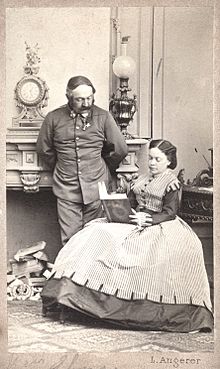Moritz von Ebner-Eschenbach
Moritz Freiherr Ebner von Eschenbach (born November 27, 1815 in Vienna ; † January 28, 1898 there ) was an Austrian technician , inventor , military writer and lieutenant field marshal .
Life
His father was the field marshal lieutenant and vice director of the engineering corps Wenzel Freiherr Ebner von Eschenbach († 1820, Knight's Cross of the Military Maria Theresa Order 1795 near Mannheim as a major), who came from an impoverished family and had started his career as a glove apprentice. He came from a Bohemian sideline of the Nuremberg patrician family Ebner von Eschenbach , whose exact relationship to the main line has not yet been clarified. As a 66-year-old widower, several years after the death of his son, General Staff Captain Nikolaus Freiherr Ebner von Eschenbach, who died near Aspern in 1809, he married his bride Helene Countess Dubsky.
Moritz came from this late, unusual marriage of his father. After numerous members of both families had died in the Napoleonic Wars , a civilian career was desired for him and he was given a free place at the Theresianum . After graduation, however, his urgent desire to become a soldier was not denied and he was able to attend the engineering academy from 1834. In 1837 he was retired as an engineer lieutenant. As early as 1840, the highly talented young officer, who trained himself further, was appointed professor of chemistry and physics at the engineering academy. In 1848, as captain, he married his very young cousin Marie Countess Dubsky, a niece of his mother, whose talent he promoted and who, as Marie von Ebner-Eschenbach (1830–1916), became one of the most important writers in Austria. The couple lived in Vienna until 1850 and then moved to Klosterbruck near Znaim , because the engineering academy was relocated there at that time. During this time, the Ebner-Eschenbach couple came into contact with the poet Oberleutnant Weil and other personalities from literature and art.
Ebner-Eschenbach made inventions in the military fields of application of electricity in communications, lighting, sea mines and torpedo systems. In 1863 he became a corresponding member of the Academy of Sciences. No less a person than Ernst Mach gave him the certificate that he had succeeded excellently “1. to replace the obsolete mine ignition with the electric one; 2. to make electrical telegraphy usable for field service; 3. To construct a searchlight, which should deprive the enemy of the advantage of undisturbed night work. ”Admiral Wilhelm von Tegetthoff , who was on friendly terms with him, praised his special achievements for the Navy. He also made an outstanding contribution to the world exhibitions in Paris (1867) and Vienna (1873) . His last post was the head of geniuses in the Vienna Corps. In 1874 he was retired and promoted to Lieutenant Field Marshal. His early retirement is said to have been the receipt for too great an honesty in the preparation of expert opinions.
In 1856 the Ebner-Eschenbach couple returned to Vienna, which was their main residence next to Marie von Ebner-Eschenbach's castle in Zdislawitz . The marriage remained childless, so that with the death of his wife in 1916 the Austrian line of the family died out in the male line.
Inventions
Ebner von Eschenbach's inventions were an electric mine ignition, torpedoes and searchlights.
Genealogical
Moritz Ebner von Eschenbach's father, Wenzel von Ebner, received the addition "von Eschenbach" in 1796 by imperial grace. There is currently no obvious family connection between the Austrian and Franconian families of the same name, Ebner von Eschenbach .
Individual evidence
- ↑ Antonio Schmidt-Brentano: The KK or KuK Generalität 1816–1918 ( Memento of the original from October 4, 2013 in the Internet Archive ) Info: The archive link was automatically inserted and not yet checked. Please check the original and archive link according to the instructions and then remove this notice. . Austrian State Archives, Vienna 2007, p. 40 (PDF).
- ↑ cf. in addition Gothaisches Genealogisches Taschenbuch der Freiherrlichen Häuser 1875-1917 and August Sieghart: “The Ebner von Eschenbach. Your relations with Nuremberg, Eschenbach and Austria ”in the Fränkischer Kurier September 19, 1936, p. 7: www.merkelstiftung.de , date of access: May 20, 2007
- ^ Peter Fleischmann, Councilor and Patriciate in Nuremberg, page 379
literature
- Ebner von Eschenbach Moritz Frh .. In: Austrian Biographical Lexicon 1815–1950 (ÖBL). Volume 1, Verlag der Österreichischen Akademie der Wissenschaften, Vienna 1957, p. 212.
- A. Bettelheim: Marie von Ebner-Eschenbach. (1900)
- A. Bettelheim: Marie von Ebner-Eschenbach. Work and Legacy. (1920)
Web links
- Literature by and about Moritz von Ebner-Eschenbach in the catalog of the German National Library
- Entry on Moritz von Ebner-Eschenbach in the Austria Forum (in the AEIOU Austria Lexicon )
| personal data | |
|---|---|
| SURNAME | Ebner-Eschenbach, Moritz von |
| ALTERNATIVE NAMES | Ebner von Eschenbach, Moritz Freiherr von |
| BRIEF DESCRIPTION | Austrian officer, technician and inventor |
| DATE OF BIRTH | November 27, 1815 |
| PLACE OF BIRTH | Vienna |
| DATE OF DEATH | January 28, 1898 |
| Place of death | Vienna |

